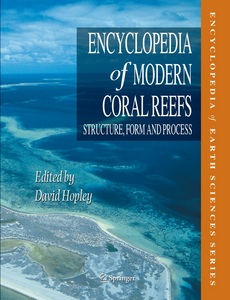Vegetated cays
Hopley, David, and Heatwole, Harold (2011) Vegetated cays. In: Hopley, David, (ed.) Encyclopedia of Modern Coral Reefs: structure, form and process. Encyclopedia of Earth Sciences . Springer, Dordrecht, Netherlands, p. 1138.
![[img]](https://researchonline.jcu.edu.au/19098/8.hassmallThumbnailVersion/19098_Hopley_%26_Heatwole_2011_Cover.jpg)
|
Image (JPEG) (Book Cover)
- Cover Image
Download (185kB) |
|
|
PDF (Published Version)
- Published Version
Restricted to Repository staff only |
Abstract
[Extract] Transformation of an unvegetated cay into a vegetated form depends to a large extent on stability, which in turn is a reflection of size and shape (Aston, 1995), availability of a source of water (a permanent water table is associated with cays with a minimum width of 300m) and a source of viable seeds (via flotsam or from bird droppings). Large oval islands are the most stable with linear islands, often with highly mobile spits and large outcrops of beach rock, the least stable. Cemented deposits, especially beach rock, can form quickly and any erosion or movement of the island results in outcrops on the beach or even isolated on the reef flat. Also forming on cays on which significant numbers of birds nest is phosphatic cay sandstone formed by interaction of bird droppings or guano with the mineral substrate. Whilst beach rock is normally intertidal, the phosphate may be precipitated at the domed surface of the water table internally within the island, (Hopley, 1997; Hopley et al., 2007).
| Item ID: | 19098 |
|---|---|
| Item Type: | Book Chapter (Reference) |
| ISBN: | 978-90-481-2638-5 |
| Date Deposited: | 21 Dec 2011 22:50 |
| FoR Codes: | 04 EARTH SCIENCES > 0406 Physical Geography and Environmental Geoscience > 040601 Geomorphology and Regolith and Landscape Evolution @ 100% |
| SEO Codes: | 97 EXPANDING KNOWLEDGE > 970104 Expanding Knowledge in the Earth Sciences @ 100% |
| Downloads: |
Total: 208 Last 12 Months: 4 |
| More Statistics |



